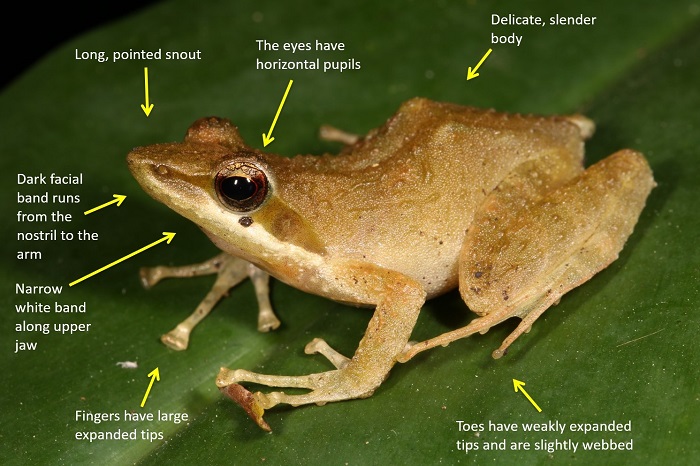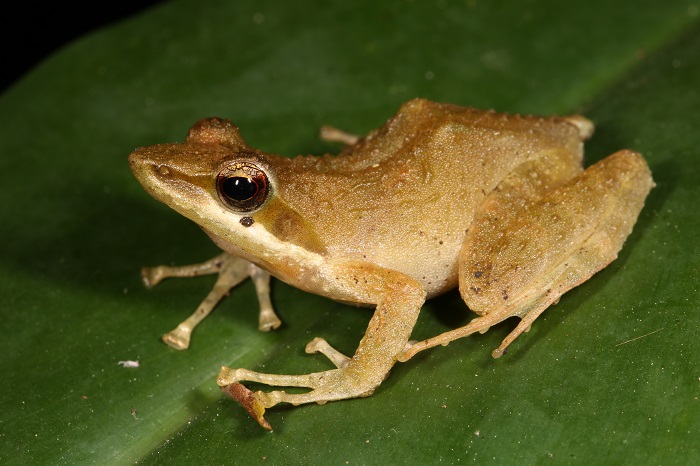View the above photo record (by Nick Evans) in FrogMAP here.
Find the Kloof Frog in the FBIS database (Freshwater Biodiversity Information System) here.
Family Pyxicephalidae
KLOOF FROG – Natalobatrachus bonebergi
Hewitt & Methuen, 1912
Identification
N. bonebergi is a small- to medium-sizedfrog, females reaching 37 mm and males 25 mm in length. They are usually brown, but may be light to greenish brown. The snout is pointed, projecting markedly over the lower jaw. The fingers and toes are long with large, truncated, terminal discs, and the toes are slightly webbed. The back has elongated skin ridges, and a light vertebral stripe is often present. A distinct black stripe runs from the tip of the snout, through the lower part of the eye to the arm.

Springside Nature Reserve, Kwazulu-Natal
Photo by Nick Evans
Habitat
N. bonebergi is always associated with forest streams and pools with rocky beds especially, but not exclusively, in ravines (Harrison et al. 2001). Typically, the frogs inhabit streams with short, fast-flowing sections alternating with longer sections of slow-flowing water and pools of varying size and depth. Eggs are deposited on vegetation or rock surfaces overhanging water.
Behaviour
These frogs are strong jumpers and can be difficult to catch. They take readily to water, swim well, and usually dive to the bottom where they hide in rotting plant material.
Breeding takes place October–May, along shallow streams with overhanging vegetation. Males select perches c.1–2 m above the water, from which they utter their faint advertisement calls. Amplexus is axillary with the fingers of the male placed below or sometimes above the base of the female’s arms. Transparent masses of 75–95 eggs are attached to leaves, twigs, tree trunks, or rock surfaces overhanging pools. The diameter of the egg mass is 75–108 mm, and the diameter of eggs is 1.5–2 mm, in 4-mm jelly capsules. Clutches may be placed in positions from just above water level to >2 m above the water, with a reported mean of 580 mm (Kok and Seaman 1989). Egg clutches are vulnerable to desiccation; in dry conditions the female moistens the clutch with liquid from her cloaca (pers. obs.).
After six days, the tadpoles are ready to wriggle out of the egg mass that becomes more liquid and sags downward. On hatching, tadpoles drop into the water to complete their development. Tadpoles are benthic and can complete metamorphosis in 60 days.
Advertisement Call
Status and Conservation
Status
N. bonebergi was not listed in previous Red Data books. In view of its restricted distribution (area of occupancy = 11–500 km2) and rate of habitat loss (>50% in the past 100 years), it has been accorded Endangered status (Harrison et al. 2001; this publication).
N. bonebergi occurs in Vernon Crookes, Oribi Gorge, Krantzkloof, Umtamvuna, Dwesa and Cwebe nature reserves.
Threats
Threats include the loss of habitat resulting from urbanization along the south coast of KwaZulu-Natal, wood-cutting in gallery forests, and crop agriculture in the form of sugar cane and tree plantations. Cooper (1988) estimated that 90% of the Coastal Forest of KwaZulu-Natal had been destroyed for the cultivation of sugar cane. Pollution and siltation of streams are factors that degrade habitat. Kok and Seaman (1989) identified three major threats to this species: the destruction of water courses and wetlands in unprotected areas, forest denudation by firewood collectors, and pollution.
Recommended conservation actions
Surveys are required to identify new populations, and known populations should be monitored: anyone walking through indigenous forest in the rainy season should be on the lookout for this interesting frog and its egg masses.
There is an urgent need to protect and manage the remaining habitat of this unique endemic species. Research into limiting factors is needed. Where remnants of gallery forest exist on private land, landowners should be informed about this species and its habitat requirements.
Distribution
N. bonebergi is endemic to the atlas region and restricted to the coastal forests of southern KwaZulu-Natal and northern Eastern Cape provinces, at altitudes below 900 m. The species is known from 18 quarter-degree grid cells, but was found in only five during the atlas period. The southernmost records are from Dwesa Nature Reserve (3228BB).
The atlas data are reliable but incomplete, especially with regard to recent records from the northern parts of the species’ range.
Further Resources
Virtual Museum (FrogMAP > Search VM > By Scientific or Common Name)
More common names: Boneberg’s Frog (Alternative English Name); Kloofpadda (Afrikaans)
Recommended citation format for this species text:
du Preez LH, Tippett RM. Kloof Frog Natalobatrachus bonebergi. BDI, Cape Town.
Available online at http://thebdi.org/2021/10/12/banded-rubber-frog-phrynomantis-bifasciatus/
Recommended citation format:
This species text has been updated and expanded from the text in the
2004 frog atlas. The reference to the text and the book are as follows:
du Preez LH 2004 Natalobatrachus bonebergi Banded Rubber Frog. In Minter LR
et al 2004.
Minter LR, Burger M, Harrison JA, Braack HH, Bishop PJ, Kloepfer D (eds)
2004. Atlas and Red Data Book of the Frogs of South Africa, Lesotho and
Swaziland. Smithsonian Institution, Washington, and Avian Demography
Unit, Cape Town.

